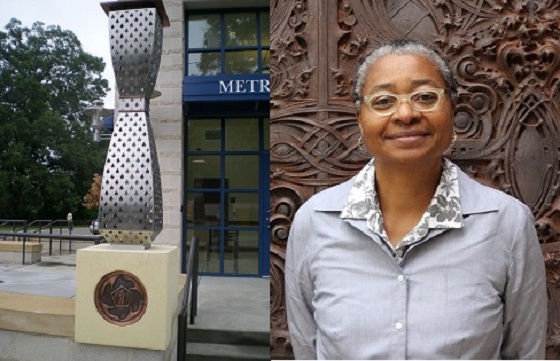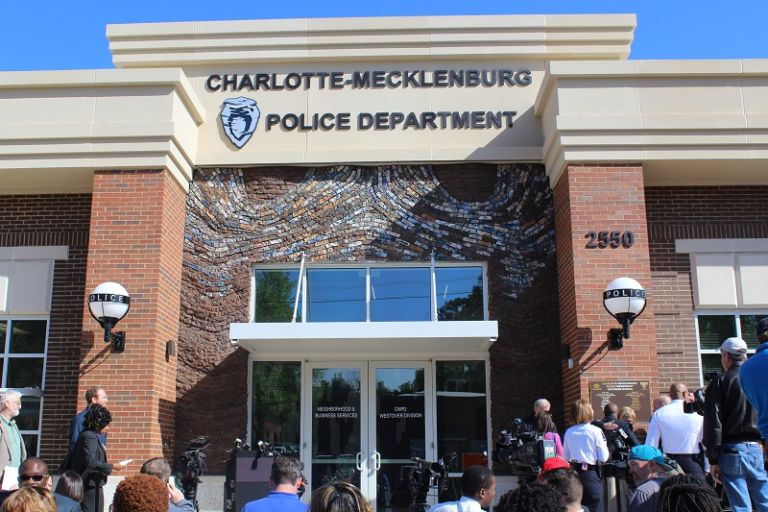Public art Reflects Relationship That Exists Between CMPD and Community

By Page Leggett
Not many adults want to go to a police station. It might be exciting for a kid on a school field trip, but otherwise, there are few happy reasons you’d ever find yourself at your local precinct.
So, what better place for public art?
Art can help soften hard edges. It can intrigue, entice, welcome. When you think about it, perhaps no place needs something beautiful at its entryway more than a police station.
“Art adds a human element,” said Todd Stewart, ASC’s vice president of public art.
There are several wonderful works doing that job at police stations throughout Charlotte.
The improbably titled “Secluded Cars in The Distant Outer Zagged Circle, Not Inner Ring Maze Puzzle, Raindrops, Pain and Good in the World. Friend, Amigo, Ban, In My Head, Seasons, Negotiating Over Space and Territory. Nice Buildings, Isaiah, Boy, Girl, Police, The Crown Is Singing, I Am the Entertainment Capital Thang. For Myself and Society, Wealth, Health, Prosperity, Home and Peace” is doing the heavy lifting at CMPD Central, the uptown precinct.
The stainless-steel wire work was created by the California-based duo Greenmeme (Freyja Bardell and Brian Howe) and installed earlier this year.
“A 20’ tall sculpture sited in the public plaza along 6th St. in front of the new CMPD headquarters,” is the brief description Greenmeme gave their work in their artist statement. “The project is symbolic of the close collaboration among police officers, community members and participants from the Urban Ministry Center [now Roof Above] in 2018. Faces of those who participated in our workshops were 3-D captured through photogrammetry.”
That’s a process involving taking multiple shots of people from a variety of angles. From there, the artists create a 3-D shape, which looks more like a typical bust.
“From these various groups, 3-D scans of participants were chosen at random to be featured in the sculpture, paying tribute to the diverse cross-section of those who define the community. The base form of the sculpture came from the idea of a queen chess piece, emblematic of the … Queen City,” described Greenmeme. “From there, we used faces of the community to ‘carve into’ that base form, refining the symmetrical representation into a nuanced and organic shape that reveals itself differently in a variety of conditions, from one’s point of view to the time of day and weather conditions. When a face was carved into the base form, it was done so in reverse, allowing for the hollow face illusion to take effect, allowing an effect where a face [appears to] continually follow you as you move around it.”
Bardell, one half of Greenmeme, said, “There is a complicated relationship between the unhoused community and the police department, but the unhoused community we spoke with largely felt like the police are there to make them safe. They are out in the community – on bicycles and walking the streets. They feel the police are approachable. They know each other – by sight, if not by name.”
In their work at the station, Greenmeme sought to convey that surprisingly friendly relationship between protector and protected.
“Greenmeme approached this very much as a community project,” ASC’s Stewart said. “It’s not a police project. It’s a community project. They did a ride-along with a CMPD officer one night when they were in town. It was in that same day we met with what is now Roof Above (formerly Urban Ministry Center, which merged with Men’s Shelter of Charlotte) as part of their art outreach. They did a lot of writing exercises with that [unhoused] group. And eventually, they had the idea of incorporating totems throughout different cultures. They really challenged assumptions of the relationship between police officers and the unhoused.”
The lengthy title of the sculpture comes from a poem generated by people at Roof Above. They responded to questions posed by the artistic team, and their responses were woven into a work of word art.
“We were trying to introduce something ethereal into what is otherwise a pragmatic process,” said artist Brian Howe. “So, we asked questions like: ‘What’s something that symbolizes Charlotte? What makes you feel safe? What is your relationship to your community?’ We got both abstract and specific answers.”
Bardell terms some of them “emotional responses.”
“It required a lot of engagement to gain the trust of the [Roof Above] community,” Howe said.
Bardell found this community especially generous and engaged: “These people were willing to share their identities – one of the only things they have ownership of – with us. We are so grateful.”
The Thread That Binds

“Connected Thread” at CMPD South was created by New York-based, Chinese-American artist Suikang Zhao and installed in 2021. Stewart called it “a work of art that demonstrates harmony and unity.”
“‘Connected Thread’ addresses the working relationship between the police department and the community,” wrote Zhao in his artist statement. “By getting both police officers and residents involved through the process of art-making, the artwork forms a personal linkage between police officers … and residents.”
Zhao relishes any opportunity he has to create public art.
“Art doesn’t belong in an ivory tower,” he said. “It’s not always meant to be hung on a white wall.”
The work is a shallow sculpted relief attached to the station’s façade. “It’s a very energetic and dynamic kind of abstract pattern that responded completely to the architecture,” Stewart said. “Then, Suikang collected words from officers and community members and translated them into 24 languages. It’s a piece that’s reflective of the community and the different perspectives within that. It’s exciting to look at as well as a deeply meaningful artwork.”
The words collected from police officers and residents are: Life, Earth, Water, Grateful, Community, Kindness, Empathy, Compassion, Truth, Spiritual, Beauty/Beautiful, Peace/Peaceful, Love, Blue, Green, Unite/Unity, Growth, Friend(ship), Relationship, Nature, Respect, People, Courtesy, Teamwork.
“It is stunning at night,” Stewart added, referring in part to the blue light Zhao added behind the sculpture which is visible after sunset. “The light really gives a whole other element to it.”
Zhao taught art in China before he came to the U.S. Since 1996, he has been teaching at the Fine Arts Department of the Fashion Institute of Technology at the State University of New York (SUNY). Now he is an associate professor and head of the sculpture department.
Issues of Identity

“Who Do You Say I Am?” by Kansas City-based artist Beth Nybeck was installed in 2021 at CMPD University.
The steel sculptures appear to be crescent moon shapes on one side, but walk around to the other side, and you’ll see that each moon is actually a partial face in silhouette. Perhaps this suggests that people may be different depending on what phase of their life you meet them.
“Who Do You Say I Am?” wrestles with our perceptions. As we encounter people, our interactions shape our view of them. The longer and more in depth our experience, the more information we have to understand them. However, if our time is short, we get only a brief glimpse into who that person is. Within that … instant, we just scratch the surface. Our perceptions may be on point – or totally off base.
This work is a reflection of the relationship that exists between the community and the police department. The seven silhouettes are actual Charlotteans Nybeck met during her time here. Some are police officers, community members or even people who have had run-ins with the law. You can get to know each person depicted in profile by reading a portion of their story on the back of the artwork.
“Beth is a very skilled metal worker with an interesting approach to public art,” Stewart said. “She works abstractly, but the work is often figurative. There’s a level of access where you can come to it and understand it. I think she works very hard to challenge assumptions and to reveal something that maybe isn’t readily understood or accepted.”
Like the other artists featured here, community engagement is crucial to her process.
“She did an incredible amount of work, collecting the stories of different community members,” Stewart said. “They all have stories, and they may not match what you immediately think of when you stereotype someone. She came up with a very elegant and smart way of exploring identity. You get the profiles of the different portraits that she collected, and they work together to create this kind of unified whole, but it’s really the inscribed stories on the back of them that reveal the whole person you wouldn’t gather otherwise. And I think it’s a simple, but really moving way, of not just talking about how people have a depth to them.”
“You think of a police officer, and it’s easy to see them as the authoritative figures they have to be successfully do their jobs,” Stewart said. “But they’re still a person and they still have a history and they still have a family they go to at the end of the day.”
“Beth is an artist who really pushes those creative boundaries and is willing to tell stories that don’t always get told, especially in public spaces.”
Finding Commonality

All the artists commissioned to create work for CMPD precincts sought to showcase the relationships between police and community, between protector and protected.
In “Finding New Ground,” installed in 2011, Charlotte artist Tom Thoune created both lobby and exterior artwork for CMPD Providence.
The tesserae and terrazzo floor piece inside the entrance of the police station illustrates the badge of CMPD officers. Thoune was inspired by the terrazzo floors in Roman municipal buildings.
These sculptures are formed by mosaic on lightweight concrete over an internal frame. Thoune incorporated pottery – donated by the community – into the sculpture mosaic. He also hand-painted tiles with scenes inspired by visits to the community and used these in the work.
The sculptures’ pinecone form is an interpretation of the Grier Heights community symbol; pinecones are symbols of strength. They serve as a protective shield just as the police department serves to protect the neighborhood.
“Police stations are crucial facilities within our communities,” Stewart said. “And the service they provide, of course, is so important. When ASC engages with police officers, we engage with them as community members as well as city/county staff. There’s a duality within them. And the goal of ASC is not to lessen their stoicism or any of the authority, respect and dignity that go along with the badge. Art can make visible the connection of public servant to community served. It’s almost like a bridge.”
“A police station is not a place people want to go,” Stewart acknowledges. “But the artwork serves as a bridge, a gateway, a connector.”
As Suikang Zhao said of art at police stations, “This is not just about beautification. These works help people understand each other.”
###
Here’s a list of other public artworks at CMPD stations in Charlotte-Mecklenburg. All were commissioned by the city of Charlotte. Later this year, look for a new public artwork coming to CMPD Independence by Durham, North Carolina-based artist David Wilson.
“Pavers: A Story” and “Community” at CMPD Hickory Gove
- Artists: Roberto L. Delgado and Rude Calderón
- Sculpture and ceramic tile pavers
- 2020

“Partnership” with “Unity” and “Cooperation” at CMPD Eastway
- Artist: Vivienne McConnell
- Artglass
- 2014

“Protect and Lift Up the People” at CMPD Metro Division (Beatties Ford)
- Artist: Chandra Cox
- Light sculptures
- 2009

“Hornet’s Nest” at CMPD Westover
- Artist: Michael Morgan
- Sculpture
- 2015



